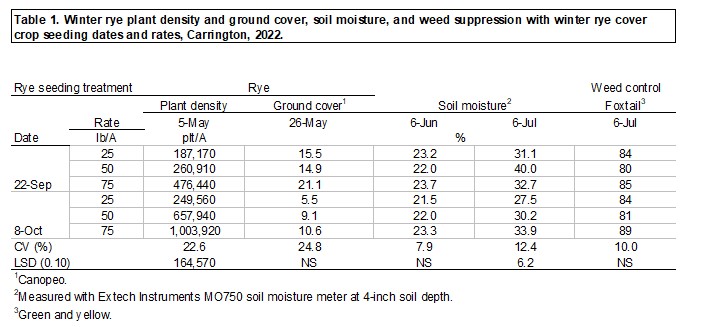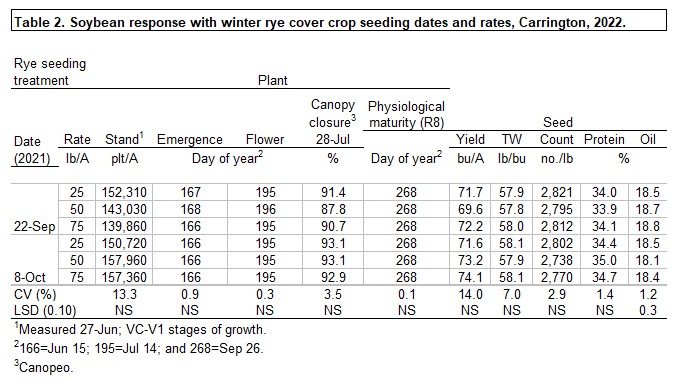The field study is being conducted at the NDSU Carrington Research Extension Center with support from ND Soybean Council to examine impact on soil, weeds, and soybean with winter rye seeded on two fall dates and at three rates grown as a preplant cover crop. Study objective is to identify rye plant populations, using combinations of seeding dates and rates, for reaching goals with the cover crop including soil and weed management while maintaining high potential for soybean seed yield. Experimental design was a randomized complete block (split-plot arrangement for rye: main plot=seeding date; subplot=seeding rate) and four replications. The dryland trial was established on Heimdal-Emrick loam soil with 2.3% organic matter, 8.0 pH, 5 ppm P, 151 ppm K, and 0.24 mmho/cm soluble salts (0- to 6-inch depth). ‘ND Dylan’ rye (99% germ. and 16,670 seeds/lb) was direct seeded into barley stubble on September 22 and October 8, 2021 at seeding rates of 25, 50, and 75 lb/A (PLS/A: 25 lb=414,320; 50 lb=828,430; 75 lb=1,242,950). Early seeded rye was at 4-leaf growth stage and late-seeded rye was 1 leaf at close of growing season (early November). Jointing to boot stage rye was terminated on June 3, 2022 with glyphosate (Roundup PowerMax at 32 fl oz/A). ‘AG03XF2’ soybean was direct-planted into barley and rye residue in 22-inch rows on June 6. Weeds were hand-rogued on July 8 and glyphosate POST-applied on July 13 across the trial for general weed control. NDAWN monthly rain (inches) in 2022: May=6.7; June=2.9; July=1.5; August=1.2; September=0.6; and 5-month total=12.8. Seed was harvested with a plot combine on October 4.
Averaged across rye seeding rates, early seeded rye averaged 308,170 plants/A with ground cover at 17% and late seeded at 637,140 plants/A and 8% ground cover when evaluated on May 5 (stand) and May 26 (ground cover), Averaged across seeding dates, rye plant density and ground cover among the three seeding rates: 25 lb/A = 218,370 plants/A and 5%; 50 lb/A = 459,420 plants/A and 11%; and 75 lb/A = 740,180 plants/A and 17%.
Table 1 indicates rye plant density and ground cover, soil moisture, and weed control with the interaction of seeding dates and rates. Plant stand ranged from 187,170 plants/A (4 plants/ft2) to 1,003,920 plants/A (23 plants/ft2) with highest density obtained with late seeding at 75 lb/A. Ground cover, evaluated in late May before soybean planting, was similar among treatments. Soil moisture, electronically measured at 4-inch depth at soybean planting time and one month later, generally was similar. Foxtail control, visually evaluated about a month after rye was terminated, was similar (80-89%) among rye treatments.
Table 2 indicates soybean performance with the interaction of rye seeding dates and rates. Soybean plant stand (trial average of 150,210 plants/A), development (emergence, flower and maturity) and canopy closure were similar among rye treatments. Soybean seed yield (trial average of 72.1 bu/A), test weight, seed count, protein and oil generally were similar among treatments.


